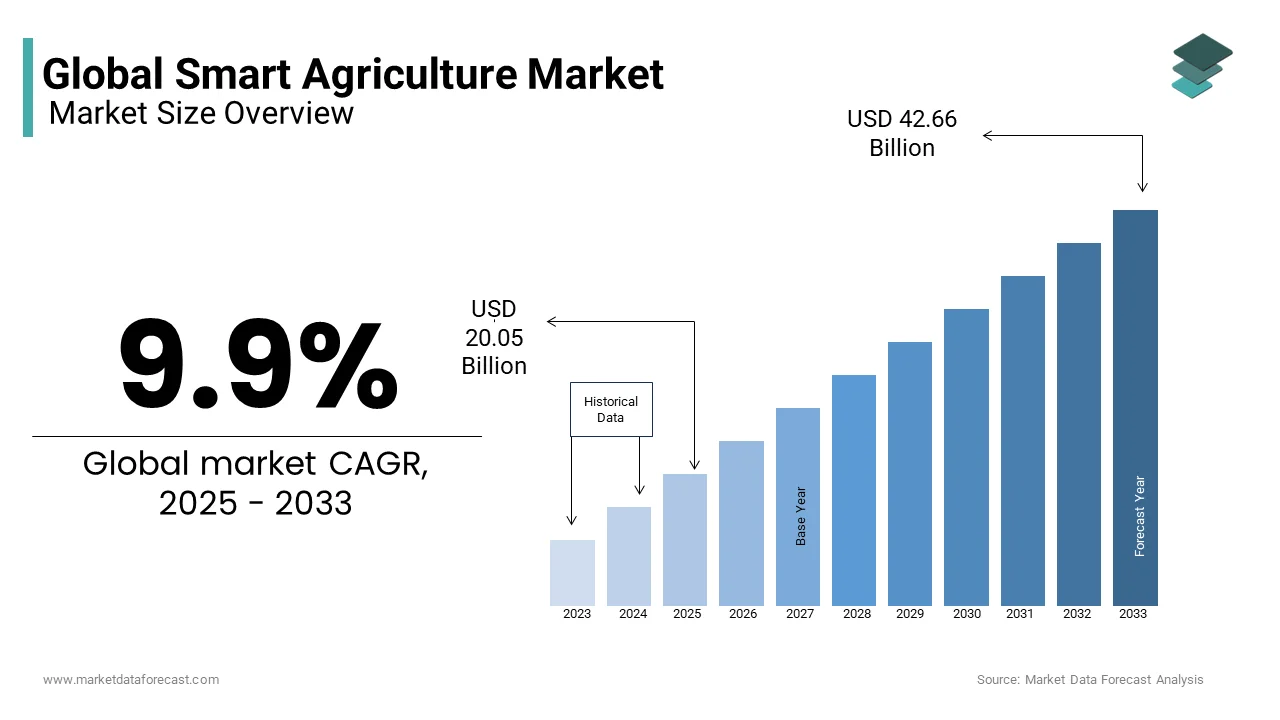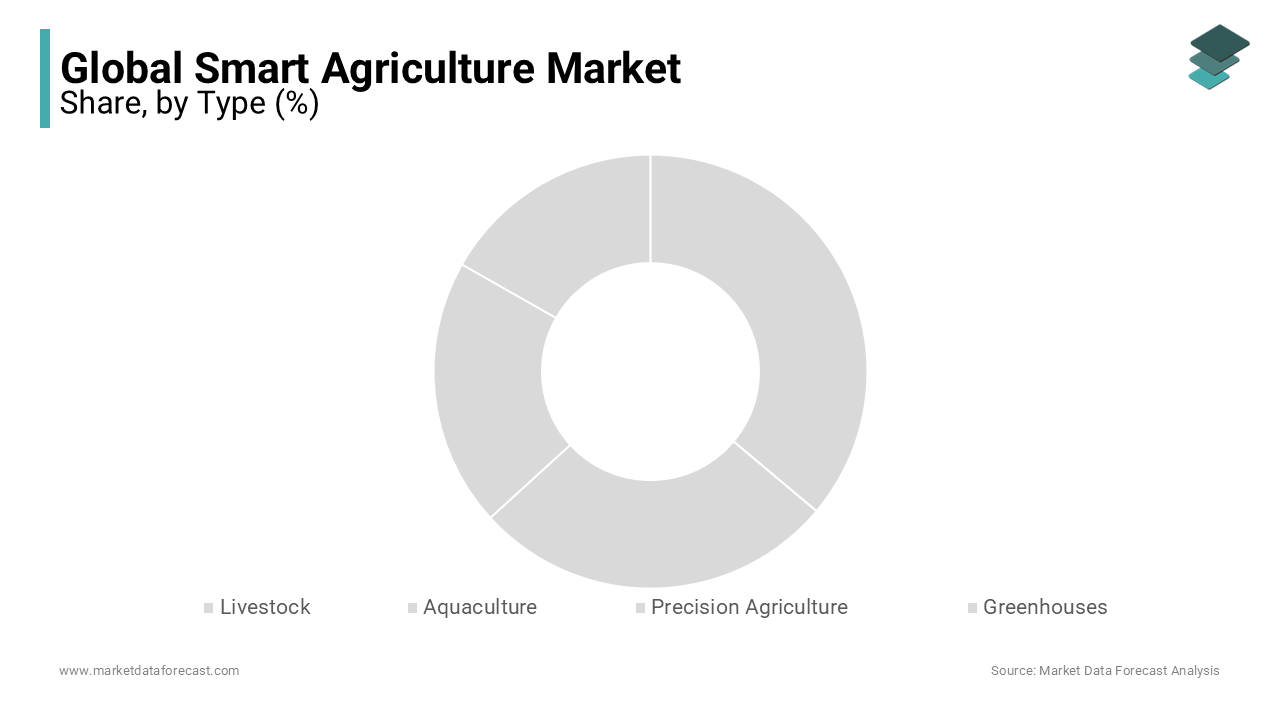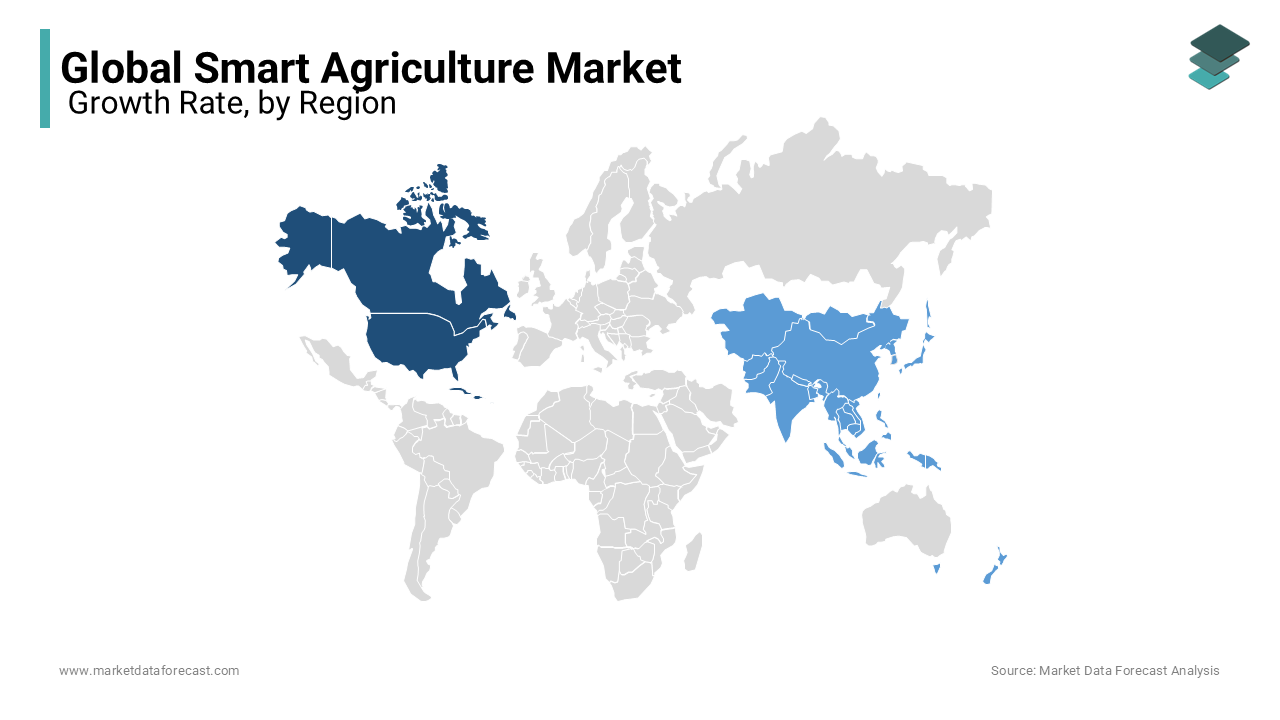Global Smart Agriculture Market Size, Share, Trends & Growth Forecast Report – Segmented By Agriculture Type (Livestock, Aquaculture, Precision Farming, Greenhouse), Offering (Hardware, Software, Services), Application (Precision Farming, Precision Forestry, Livestock Monitoring, Precision Aquaculture, Smart Greenhouse), Regional Analysis (North America, Europe, Asia Pacific, Latin America, Middle East & Africa) - Industry Analysis From (2025 to 2033)
Global Smart Agriculture Market Size
The global smart agriculture market was valued at USD 18.24 billion in 2024 and is anticipated to reach USD 20.05 billion in 2025 from USD 42.66 billion by 2033, growing at a CAGR of 9.9% during the forecast period from 2025 to 2033.

CURRENT SCENARIO OF THE GLOBAL SMART AGRICULTURE MARKET
Smart agriculture can be defined as the process of conducting agricultural activities using advanced technology.
It is an innovative way of doing agricultural activities by reducing human effort and making the most of available resources. Precision agriculture includes automation systems and detection devices. The application and feasibility of smart farming devices will depend on the economic conditions and scale of the farmland. The high-tech products used in smart agriculture have a wide range of applications including yield monitoring, field mapping, crop recognition, as well as milk collection, irrigation management, and more. Smart farming is the process of using advanced technology to carry out agricultural activities. It is an innovative way to carry out agricultural activities by reducing human effort and making the most of available resources. Smart farming includes agricultural activities that use the Internet of Things (IoT) and sensors to increase farm productivity.
MARKET DRIVERS
The introduction of IoT, GPS, and wireless connectivity is driving the global smart agriculture market.
The increasing pressure on the food supply system is driven by the rising use of modern technology, the rapid growth of agricultural product populations, and the growing interest of farmers in monitoring livestock and detecting diseases to facilitate the growth of smart irrigation systems. Smart farming targets large-scale conventional farming and other agricultural trends like family farming, organic farming, etc. In direct proportion to population growth, the demand for food is also supposed to increase exponentially during the conjecture period. Most livestock is susceptible to viral infections and attacks, which can increase livestock mortality. Various types of RFID tags, readers, and sensors are implemented to monitor livestock health and activity. In view of the growing demand for food, farmers must increase crop production by increasing the amount of agricultural land or adopting advanced agricultural methods such as precision farming. The key factors driving the market growth are the rising demand for food around the world, the growing need for control of livestock health and performance, and increased government support for the adoption of modern agricultural technologies. Market demand is increasing again as the use of smart technologies to monitor livestock, reduce labor costs, and increase yields increases. The market is growing rapidly due to favorable government support for adopting modern agricultural technologies to increase product production. The growing world population with a growing demand for agricultural yields to meet world demand is accelerating market growth. Governments around the world are partnering with a variety of food and beverage manufacturers, agricultural processing organizations, and financial institutions to develop sustainable agriculture initiatives. These initiatives aim to increase the efficiency and productivity of farmers and provide more food security.
Furthermore, public-private partnerships in developing countries such as India, China, and Brazil will create more income opportunities for farmers, promoting the growth of the smart agricultural market. Smart farming can ensure high returns for your agribusiness once you get used to its full potential. It collects geospatial data from livestock, soil, and plants, as well as other internal and inter-field information, which can help farmers combat the negative effects of nature on their crops. Precision agriculture also reduces agricultural costs by providing information on the required amount of liquid fertilizer, irrigation water, herbicides, nutrients, and pesticides, reducing wasted resources. Improving business efficiency by automating processes and improving production by reducing agricultural costs are two important factors driving the deployment of smart agricultural tools. With precision agricultural technology, your agricultural business will be more profitable than ever. Additionally, various agricultural industries are working with various European governments to implement advanced technologies such as IoT and machine learning to help farmers efficiently plan and execute a variety of agricultural tasks. Therefore, it provides a favorable opportunity for market growth. Smart farming also uses a variety of methods to deliver manual media and nutrient solutions to plant roots, which are more expensive than other farming methods.
MARKET RESTRAINTS
Some of the factors limiting the growth of the global smart farming market size are the high cost of the devices used in smart farming and the lack of awareness of farmers. Compatible devices and better-quality network connections can disrupt the market in some developing countries, as well as in remote areas with network problems. The high costs incurred in manufacturing smart farming devices are likely to drive up the price of the final product, restricting market growth during the envisioned period. The main factor slowing the growth of the global smart agriculture market is the high demand for initial investment. Currently, smart farming tools are expensive, which is uneconomical for small farmers in developed regions and most farmers in emerging economies. Therefore, the latest technology is only accessible on large, industrialized farms due to the high technical cost.
REPORT COVERAGE
|
REPORT METRIC |
DETAILS |
|
Market Size Available |
2024 to 2033 |
|
Base Year |
2024 |
|
Forecast Period |
2025 to 2033 |
|
CAGR |
9.9% |
|
Segments Covered |
By Agriculture Type, Offering, Application, and Region |
|
Various Analyses Covered |
Global, Regional, & Country Level Analysis; Segment-Level Analysis, DROC, PESTLE Analysis, Porter’s Five Forces Analysis, Competitive Landscape, Analyst Overview of Investment Opportunities |
|
Regions Covered |
North America, Europe, APAC, Latin America, Middle East & Africa |
|
Market Leaders Profiled |
AGCO Corporation, AG Leader Technology, Inc., Raven Industries, Inc., SemiosBio Technologies, Inc., Precision Planting LLC, GEA Group, The Climate Corporation, SST Development Group, Inc., Trimble Inc., TOPCON, and Others. |
SEGMENTAL ANALYSIS
Global Smart Agriculture Market By Type

Of these, precision agriculture had the largest market share in 2019 at over 49% and is supposed to grow at the highest CAGR of around 13% during the foreseen period.
Global Smart Agriculture Market By Offering
On a software basis, Cloud-based software had the largest market share at around 58% in 2019. It is expected to grow at a CAGR of around 12% over the forecast period. Cloud-based software is gaining ground due to the growing number of applications. By service, systems integration and consulting recorded the largest market share with around 31.50% in 2019. It is foreseen to grow at a CAGR of around 13.10% during the envisioned period. The demand from the consulting and systems integration sector is increasing with the rising application and adoption of advanced devices in agriculture.
REGIONAL ANALYSIS

North America has led the global smart agriculture market and is foreseen to maintain its leadership position for years to come. Increased government investment in research activities to minimize human intervention and increase crop yields is determined to boost smart agricultural markets in North America in the near future. Europe is expected to come in second place thanks to the great contribution of the UK.
Asia Pacific has been leading the global smart agriculture market and is estimated to continue to occupy a dominant position in the future. The growing call for food and other dairy products is a major factor behind the dominance of the Asia Pacific smart agriculture market. The dominance may be due to rapid population growth in countries like India and China and augmented demand for food in the region. In addition to this, the rural economies of the countries of the APAC region are based on agriculture, which will further increase the need for advanced technologies in agriculture for a higher crop harvest, supporting the trends of the smart agricultural market.
KEY MARKET PLAYERS
Major Key Players in the Global Smart Agriculture Market are AGCO Corporation, AG Leader Technology, Inc., Raven Industries Inc., SemiosBio Technologies Inc., Precision Planting LLC, GEA Group, The Climate Corporation, SST Development Group, Inc., Trimble Inc., TOPCON, Auroras srl, Agribotix LLC., DeLaval, Deere & Company, Grownetics, Inc. Etc.
RECENT HAPPENINGS IN THIS MARKET
- DeLaval, in cooperation with the Swedish University of Agricultural Sciences (SLU), installed the DeLaval VMS V300 at the Lövsta Research and Education Center (Sweden).
MARKET SEGMENTATION
This research report on the global smart agriculture market is segmented and sub-segmented into the following categories.
By Type
- Livestock
- Aquaculture
- Precision Agriculture
- Greenhouses
By Offering
- Hardware
- Software
- Services
By Application
- Precision Farming
- Precision Forestry
- Livestock Monitoring
- Precision Aquaculture
- Smart Greenhouse
By Region
- North America
- Europe
- Asia Pacific
- Latin America
- Middle East and Africa
Frequently Asked Questions
How does the smart agriculture market differ between Europe and Asia-Pacific?
In Europe, the market is driven by stringent regulations promoting sustainable farming practices, while in Asia-Pacific, rapid urbanization and the need for increased food production are driving market growth.
What are the unique challenges faced by the smart agriculture market in Africa?
Challenges in Africa include limited access to technology and infrastructure in rural areas, as well as the need for tailored solutions considering the diversity of agricultural practices across the continent.
How is the Middle East contributing to the development of smart agriculture?
In the Middle East, the focus is on mitigating the impact of water scarcity through precision irrigation techniques and adopting technologies like hydroponics and vertical farming to optimize resource utilization.
How does the regulatory landscape differ for smart agriculture in Europe compared to Asia-Pacific?
Europe has stricter regulations regarding data privacy and environmental sustainability, leading to the development of innovative solutions focused on compliance, whereas in Asia-Pacific, regulations often prioritize food security and agricultural modernization.
How is the Middle East contributing to the development of smart agriculture?
In the Middle East, the focus is on mitigating the impact of water scarcity through precision irrigation techniques and adopting technologies like hydroponics and vertical farming to optimize resource utilization.
Related Reports
Access the study in MULTIPLE FORMATS
Purchase options starting from
$ 2500
Didn’t find what you’re looking for?
TALK TO OUR ANALYST TEAM
Need something within your budget?
NO WORRIES! WE GOT YOU COVERED!
Call us on: +1 888 702 9696 (U.S Toll Free)
Write to us: sales@marketdataforecast.com